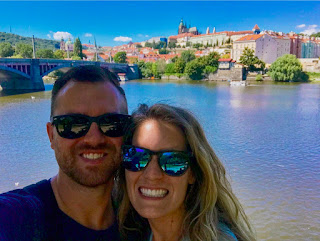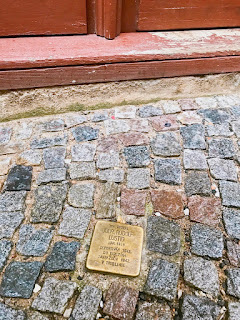Prague
I'm writing this while sitting on a six hour train ride from Prague to Munich. We just finished spending five amazing days in Prague, and I think it's safe to say that it has officially become one of our favorite European cities. I don't think either of us knew what to expect when we decided to visit Prague, but to say it is beautiful might be the understatement of the year.
We learned so much about this amazing city and country. It has a fascinating history- one that neither of us had any idea about. We heard from a tour guide that if you lived in Prague throughout the 20th Century, then you changed nationalities eight times without ever changing your address. Craziness, right?
Similar to other European countries, it has a terrible history of being under the Nazi Regime during World War II, but after WWII, it didn't recover in ways that most of the others did. It (Czechoslovakia at the time) became a communist country under the Soviet Union. The country of the Czech Republic ("Czechia") has only been in existence for about 26 years when it gained independence from the USSR in 1990 and split from Slovakia in 1993. So needless to say, we spent a lot of time reading about the country's history and learning about how far it has come since the 90s.
Because of its long and changing history, Czechia has architecture ranging from very old to modern. The city has a river running through the middle of it splitting Old Town Prague from Mala Strana ("Lesser Town"), and the views from both sides of the water were unbelievable.
We spent a lot of time admiring the sights throughout the city.
Several times we walked across the Charles Bridge, which was built by Charles IV in the late 1300s.
We visited the Prague Castle, which was declared the largest ancient castle in the world by Guinness Book of World Records at over 750,000 sq. ft. It doesn't really look like what we would traditionally think of as a "castle"; it appears to be more of a palace. The Castle is made up of numerous buildings and even has its own cathedral.
We spent a day in Kutna Hora, which was about a one hour train ride away from Prague. The town was very interesting and had several UNESCO World Heritage sites including two churches and one ossuary. The Sedlec Ossuary is filled with the bones of around 60,000 humans which are formed into decorations throughout the building. The chandelier is made up of at least one bone from every part of the human body, and there is the coat of arms of one of the wealthier Czech families made of bones as well. It was really bizarre and has an interesting history if you have a moment to look it up. It also poured rain for most of the afternoon we were there so that wasn't the best...
And as usual, we ate some delicious food and treats. Perry enjoyed some Czech smoked pork knee. We also loved these delicious treats called trdelniks. Perry ate one with chocolate ice cream on top, and I had one with salted caramel glaze on the inside. My mouth is watering just thinking about them.
During our time in Prague, we were introduced to these things called Stopersteine or "stumbling stones", which are 10 cm x 10 cm brass plates inscribed with the names and life dates of victims from World War II. They are placed outside of the victim's last known residence. Neither of us had ever heard of them before, but after doing some research, it's estimated that there are more than 70,000 of these little plates throughout 1,200 cities and towns across Europe and Russia. After they were pointed out to us, we started finding them outside of many places throughout Prague and Kutna Hora.
These plates were so fascinating to me as they represented a small way to commemorate someone whose life was taken far too early for horrific reasons beyond their control. Throughout our time in Europe, I've been amazed by the Europeans' acknowledgement of the horrors of WWII. It would be so easy for them to try to forget what happened and move on, but they don't do that. They recognize that tragedies were committed and use this recognition to learn from the past in order to prevent such horrors from happening again.
There's profoundness in that. It takes away the power of the oppressor and gives power to the oppressed. It requires us to look at history and say "Where did we mess up? And how do we keep this from ever happening again?" It makes sure that those that suffered aren't forgotten and their memory can live on in a way that hopefully changes the trajectory of history because of lessons learned.
Reflecting on this, it makes me think back to times in my life where I need to learn from my past, where I need to make changes in the future to better the world around me. Were there times when I judged someone too quickly or said something unkind or didn't say anything at all to stand up for the oppressed and hurting?
So today, may we all learn to acknowledge the times that we messed up. May we not hide from our pasts and instead embrace them as lessons learned. And in honor of the Bloch, Benda, Steinerova, Lustig and Winternitz families of the world, may we all learn from our "stumbling blocks" and use them to inspire a better future.
























































































I think Prague just moved up my list :) Thank you for taking the time to share your adventures and reflections. Beautiful pictures! Love you guys XX
ReplyDeleteErin ;)
Delete